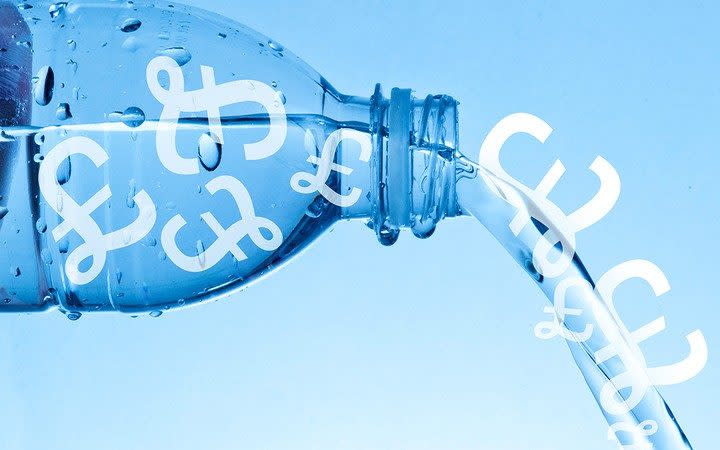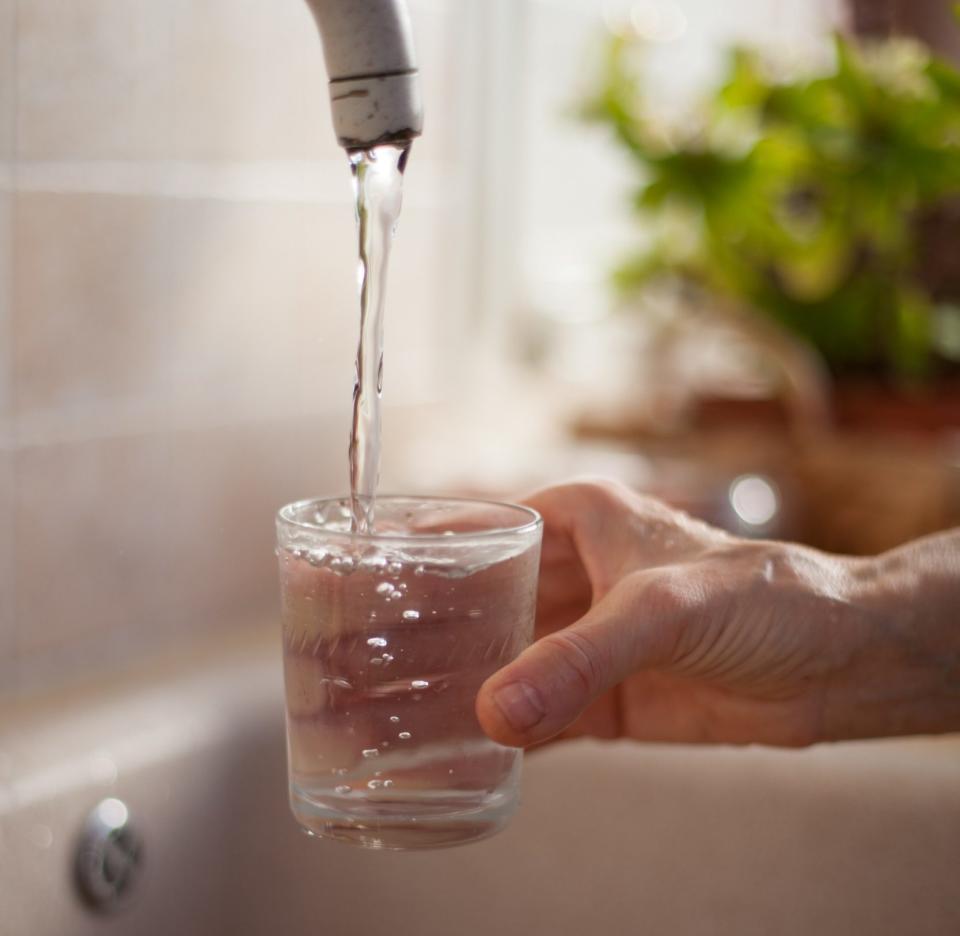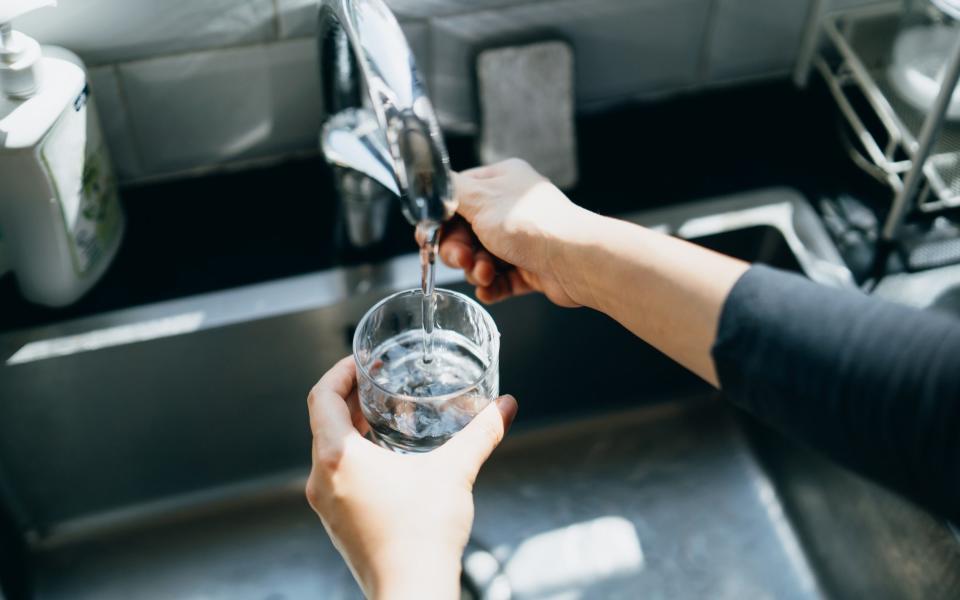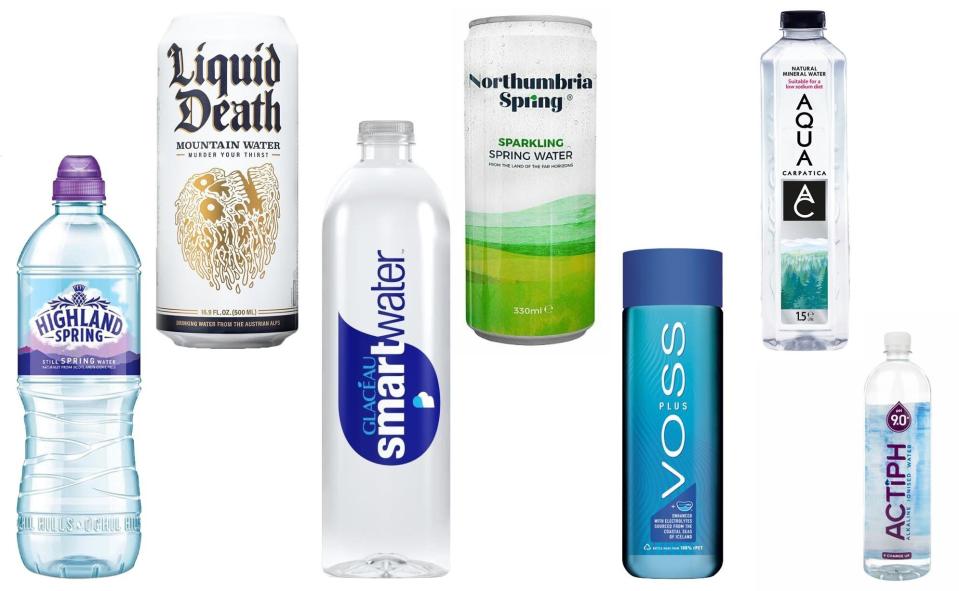'It’s ludicrous that so much damage is being caused by a product you can literally get on tap'

When Blue Planet II hit our screens in 2017, bringing magnificent scenes of killer whales hunting and sharks chasing turtles, the main talking point turned out to be plastic, including the devastating impact of plastic particles in water. The “Blue Planet effect” saw plastic straws vilified and a rise in reusable water bottle sales.
Yet, according to a 2023 report by Retail Economics, 2.8 billion bottles of water – the overwhelming majority plastic – will be sold in the UK by 2026, up from 2.5 billion in 2021. Which is astonishing when you consider the latest findings that a single bottle of water contains a quarter of a million pieces of plastic.
The global water industry, worth $286.3bn in 2022, is projected to rise to $484.7bn by 2030. Millennials have been cited as the most frequent buyers.
Strong shelf appeal
At my nearest Tesco I counted new fewer than 10 water brands; the same amount, with some crossover, at my local corner shop. There were the classics – Evian, Volvic – and a mind-boggling array of arrivistes flogging “smart” water, water “enhanced with electrolytes”, or “alkaline-ionised water”. No, me neither.
Brands are racing to quench our thirst, and in 2023 a new upstart joined the party, promising to fizz up the industry with a rock’n’roll aesthetic and 500ml beer-style cans. Liquid Death is sold at Co-op, where I found it next to crates of Staropramen lager, and the brand took inspiration from energy drinks, promising a healthier liquid in amusing packaging.
The American company was founded by Mike Cessario, a graphic designer who has worked for Netflix. In 2020, when it launched in Whole Foods stateside, it became the “fastest-selling water brand”, according to Eater. Eschewing traditional advertising, it partnered with celebrities like skateboarder Tony Hawk and Blink-182’s heavily tattooed drummer Travis Barker. Liquid Death is sponsoring Metallica’s ongoing two-year world tour, and was sold at a number of UK festivals last summer. The message is clear: even punks need water.

According to Cessario, it’s one of the three most followed beverage brands on social media globally. “We approach our creative work like an SNL [Saturday Night Live] writer’s room,” Cessario told The Telegraph. “We know we can win if we make people laugh, and we will appeal to anyone with a sense of humour.”
A touch of genius? Perhaps, considering that, in some people’s eyes, it’s plain old water. (At £1.50 per 500ml, it’s far pricier than many established waters.)
Britain was Liquid Death’s number one market in terms of website traffic and requests to launch, according to Cessario, so it “made sense as our first international expansion”. But why are we so keen on water from the Austrian Alps, which Liquid Death has trademarked as Mountain Water? Why do we want such a range at all?
The real reasons we buy mineral water
Last summer, in a Censuswide survey commissioned by the Natural Source Waters Association (NSWA), which represents bottled mineral waters in the UK, respondents cited mineral water being “natural”, “healthy”, “pure” and “tasty” as the key reasons they purchased it. For each answer, the percentage had grown since a similar survey in 2021.
Bottled water brands, many owned by huge international corporations, are experts at marketing. They evoke purity – pristine mountains, water passing through rocks, picking up vital minerals. Highland Spring offers “nature’s magic potion… sourced directly from 2,500 acres of wild rugged, protected land”. Buxton’s water’s journey “began 5,000 years ago. From the rain that fell upon the rolling hills of the Derbyshire Peak District”. Volvic asks us to “harness the power of the volcano”, while Evian, more sedately, comes from a “pristine and protected Alpine mountain source.”
Many water brands advertise health benefits, and most bottled water contains electrolytes and minerals like potassium, magnesium and calcium. These are “key elements the body needs,” says Dr Frankie Phillips, a spokesperson for the British Dietetic Association. Whether naturally occurring or added, water can provide a boost, but many mineral waters, says Dr Phillips, “contain minuscule amounts which wouldn’t be that significant to make an impact on general health”.
Tap water also contains most of these minerals, plus fluoride, vital for oral health. A healthy, varied diet containing a range of fruit and vegetables would “way surpass” the amounts of potassium or calcium found in water. Bottled waters promising electrolytes to help athletes hydrate aren’t taking us for a ride, but Philips says most recreational athletes would be fine with tap water and yoghurt or fruit.
An argument for greater choice
For bottled water proponents, choice is crucial, not only between waters but between water and soft drinks. After all, faced with a dizzying line-up of colourful, sugar-filled bottled drinks, water is the healthy choice. Soft drink sales, it must be noted, are also rising.
Taste is frequently cited as a reason for buying bottles. According to Doran Binder, owner of Crag Spring Water and a trained water sommelier, the prevailing attitude in Britain is “water’s water, mate, isn’t it”. He believes that’s far from the truth. “Tap water is highly processed, compared to naturally occurring organic springs.” Mineral water, he says, can have superior taste, flavour and mouthfeel.
Choice is wonderful, but do we really need this much, especially waters shipped from around the world? Fiji Water is quite nice, but travels 10,000 miles to get here. Volvic and Evian only cross the Channel, but according to Nolan Wright, director of supply chain operations at Belu, “we’ve got enough water sources in the UK to meet our demand. Imported water just creates another challenge in terms of packaging being shipped all over the globe”.
It’s why Belu, one of the growing number of avowedly “eco-friendly” water companies, doesn’t export. Ironically, it started life as a campaigning group against bottled water. In the mid-1970s, Britons consumed around 300ml of bottled water per head annually, rising to 37 litres in 2021. In that climate, Belu realised trying to improve the industry, rather than abolish bottled water, was more feasible.
Today it supplies hospitality and individual customers with water, mostly in glass bottles, as well as offering a tap filtration system to hospitality; 100 per cent of net profits go to WaterAid. Bottling water from rural Powys, Wright is understated on its credentials. Can consumers discern its mineral water? “That’s debatable on bottled water versus tap,” says Wright. “The UK is fortunate to have good tap water, so it goes down to personal choice.”
Concerns for our health and the planet
Millions choose bottled for taste, purity, even health, but what about plastic? A 2018 study found 93 per cent of bottled waters contained microplastics, while a recent study by Columbia University has shown that the actual amount of plastic pieces floating in water is up to 100 times more than previously thought when including nanoplastic particles. However, tap water also contains microplastics, though less, according to Peter Jarvis, head of the Cranfield Water Science Institute. The World Health Organisation has said that there is “insufficient information to draw firm conclusions on the toxicity related to the physical hazard of plastic particles”.
The creation and recycling of bottles is also of concern. Belu was an early adopter of recycled PET plastic, which can be fully recycled, and everyone the Telegraph spoke to said 100 per cent recycled PET, which many brands now use, is probably the best option.
“Plastic isn’t actually that big a problem, in terms of production and recycling,” says Adam Herriot, a resource management specialist at the Waste and Resources Action Programme (WRAP). The energy used to create aluminium and glass is far greater, the final products heavier to transport. “The problem is us, and what we do with it once we’re done, throwing it away or littering it.”
In the UK, nearly every local authority recycles PET bottles, and Herriot says we have a recycling rate of around 75 per cent. Globally that isn’t the case, and plenty of virgin plastic is still used to create bottles.
Even if a quarter of plastic bottles are discarded, that is still alarmingly high, considering the well-documented impact on wildlife and the rise of plastic particles in our waters. Globally, only nine per cent of plastic gets recycled, while three-quarters of the aluminium ever produced is still in use, which is why canned water is increasing in popularity. “We went with aluminium because it is far and away the most economically viable material to recycle,” says Cessario. Aluminium is infinitely recyclable, though requires a high energy input.

Are glass bottles the answer?
For some, glass is the future. Binder started Crag Spring Water after discovering a pristine mineral water source below his Cheshire pub in 2016, and now sells to Michelin-starred restaurants and private customers. “Single-use glass is a bigger offender than single-use plastic,” Binder explains, citing the energy to create and transport it. “Plastic gets all the bad press, but single-use glass gets away with murder. To use glass once is a national disgrace, and to send it to be crushed and turned back into what it was in the first place shows how deluded we are.”
Glass has a trump card – it can be reused thousands of times. Binder started a refill service where bottles are collected, cleaned and refilled, some in conjunction with the Modern Milkman. Belu, which says it has produced the lightest glass bottle made in the UK, which it sells to other companies, also launched a refill service in 2023 with Milk & More. The old-school milkman, it seems, is improving the sustainability of bottled water.
For its part, the NSWA advocates for a deposit return scheme, where customers pay a small deposit on each bottle and recoup it on returning it to a supermarket. “We were hoping it was going to come into Scotland in the summer, but that’s been delayed,” says Kinvara Carey, the NSWA’s general manager. They’re hoping for a UK launch in 2025.
A 2021 study by scientists at the Barcelona Institute for Global Health found that bottled water’s impact on the environment is up to 3,500 greater than tap. Many parts of the world don’t have access to safe tap water, but that isn’t the case in the UK. While treated with chlorine, it is “completely safe to drink”, says Dr Phillips, and is inspected daily.
A 2023 report commissioned by the water filter manufacturer Brita found that 54 per cent of bottled water is consumed where a tap is readily available. “In a country where tap water is some of the best quality and safest to drink in the world, it’s ludicrous that so much environmental damage is being caused by a product you can literally get on tap,” says David Hall, Brita’s UK managing director.
There are times when bottled water is the only option. It’s a far healthier alternative to soft drinks, and has a lower environmental impact than them. Sparkling water, also rising, is harder to come by from a tap. “We’re creatures of convenience,” says Herriot, who says refilling a reusable bottle is the most sustainable way to hydrate. While he insists the Blue Planet effect is real, change in behaviour may lag behind consciousness.
Our thirst for water is growing, but so is our thirst for convenience – for now, that means more bottles.
Mineral water taste test

Voss Plus
The bottle is made with 100 per cent recycled PET, and promises a “refreshing, extra-hydrating water infused with Aquamin, a unique blend of 74 trace minerals and electrolytes, sustainability sourced from the coastal seas of Iceland”. The water is aimed at “the physically active and on-the-go,” and is designed “to take you farther”.
There’s a slight salinity to the taste, a little sweetness as well, and it does taste minerally, with a smooth, slightly dry finish.
Highland Spring
The bottle and cap are made from 100 per cent recycled plastic, but the bottle doesn’t make any bold claims, just promising “still spring water” and offering a breakdown of minerals, including calcium, chloride, potassium and sodium.
It’s very bland (which, I suppose, is a good thing for water), and tastes pure and clear.
Actiph Alkaline Ionised Water
“Charge up”, says this plastic bottle with a huge label and plenty of detail. “Actiph alkaline ionised water is supercharged to pH9+, helping you take your hydration to the next pH level”, it says. With a “unique blend” of electrolytes, this water, bottled at Wenlock Spring in Shropshire, is quite sweet, with an almost fatty mouthfeel, thicker and more viscous than some.
A full-bodied water? It tastes like the soft water you get up North, my housemate says perceptively.
Glaceau Smartwater
This 100 per cent recycled plastic bottle holds “vapour distilled water with added electrolytes”, which it promises creates a distinctively “clean” and “crisp” taste. A British spring water from Northumberland with added calcium chloride, magnesium chloride and potassium bicarbonate, it doesn’t have much flavour at all – crisp and clear, indeed.
Aqua Carpatica
A mineral water straight from the Carpathian mountains, this bottle is “suitable for a low sodium diet”. Indeed, it has far less sodium than the Highland Spring, for example (0.6 mg/l as opposed to 5.6 mg/l). The bottle explains how the water has undergone “20 years of natural filtration during the underground journey of the water” from “springs in protected areas” and promises “no aftertaste”. I wasn’t aware of water having an aftertaste, but this dry, crisp bottle certainly doesn’t.
Liquid Death
£1.50 for 500ml
Sold in beer-style cans, this “Mountain Water™” hails from Austria, and promises to “murder your thirst”. The “infinitely recyclable can of stone-cold mountain water clawed its way from deep inside the earth to murder your thirst,” which sounds like Gollum. It’s clearly a tongue-in-cheek brand, but drinking water out of a can is mildly discombobulating at first. There’s no discernible flavour, no chemicals or mineral, just very plain – as water should be, really.
Northumbria Spring
Canned at source in Northumbria, this tin couldn’t be further from Liquid Death – no skull on the bottle, just serene, blue rolling hills. Apart from offering spring water from “the land of the far horizons”, there is little shouting, typical British understatement. The water, which has a higher calcium, magnesium and sodium content compared with some of the others tested, is ever so slightly salty to the taste, and a little dry, but crisp and pure tasting.
Tap water
Around 0.1p per litre
The taste and mineral composition of tap water varies around the country. If you have plenty of limescale in your kettle, you’re likely to live in an area where the water contains high levels of calcium and magnesium. However, tap water in the UK is safe to drink. Where I live in London the water is hard (lots of calcium and magnesium), and there’s a fairly strong minerally taste. There’s no denying a whiff of chlorine, too – it’s not quite as smooth or pure as mineral water.

